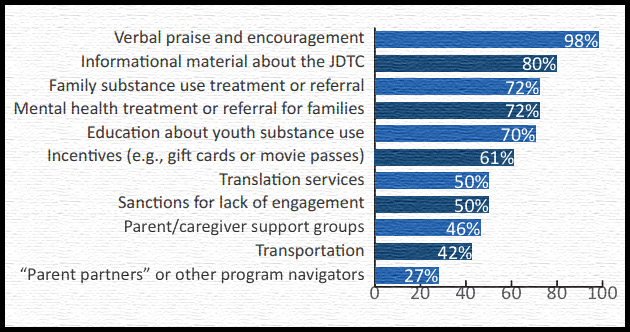An important report released this week by the National Center for Mental Health and Juvenile Justice, in partnership with the National Council of Juvenile and Family Court Judges, shows the cruciality of increasing family participation in order to improve outcomes for kids going through the juvenile drug court process. The report, which was funded by the US Department of Justice’s Office of Juvenile Justice and Delinquency Prevention, outlines a number of strategies to help drug courts struggling to increase family engagement.
Drug courts (and other alternative courts, including veterans courts and mental health courts) aim to help rather than punish people suffering from substance use disorders and other issues by offering a treatment alternative to incarceration for low-level offenders.
There has been a gap in the success rate of juvenile drug treatment courts and traditional juvenile courts, the report points out. Surprisingly, juvenile drug courts are also less successful at treating kids’ addictions and reducing recidivism than adult drug courts.
“The literature has shown a lot of success in adult drug court, but with youth—a population that would benefit greatly and has so much of their lives ahead of them—the results have not been as good,” study co-author Brett Harris, a clinical assistant professor in public health at the State University of New York at Albany told the Juvenile Justice Information Exchange.
And substance use is an extremely common problem among juvenile justice system-involved kids. While only 11% of kids in the general population reportedly struggle with substance use, 34% of kids in contact with the justice system have been identified to have a substance use disorder.
At the same time, research has revealed that including immediate and extended family members in the treatment process reduces drug use and illegal behavior among youth.
In 2015, the Office of Juvenile Justice and Delinquency Prevention evaluated nine youth drug treatment courts and found that six of the courts experienced higher rates of recidivism than traditional juvenile probation. The OJJDP report also revealed that youth drug courts weren’t evaluating kids needs or barriers to successful treatment, and generally were not following evidence-based correctional treatment practices. The report indicated that the one court that experienced significant reductions in recidivism was following evidence-based practices more thoroughly.
Various other reports have concluded that an absence of parental support, poor parenting skills, unsteady family structure, and parents’ own substance use issues pose barriers to family involvement in the alternative court process.
This week’s report gives recommendations for increasing family engagement in juvenile drug court process, with the hope of achieving greater success for the teens involved.
Researchers surveyed 157 professionals from drug treatment courts in 38 states. Nearly all of those surveyed indicated that family engagement can be essential, and kids in drug court would have better outcomes if their families were involved. Seventy-nine percent of respondents said they believed families would be more involved in kids’ court processes if transportation issues, child care, and work did not get in the way.
And 78% of the drug court professionals said holding court and other activities at family-friendly times would remove a barrier to parental and family participation.
The mental health professionals also said they believed that the three most successful strategies for boosting family interaction in the process is providing transportation, engaging other key figures who might not be part of the child’s immediate family, and providing incentives like gift cards and movie passes.
Despite acknowledging the importance of family engagement, many respondents did not know the best ways to bring families into the process. “The very low level of familiarity with engagement techniques probably surprised us the most,” Harris told JJIE. “They thought it was important to successful outcomes, and you see that in the survey results.” But the professionals from the drug treatment courts said they didn’t know the best ways to accomplish the goals, she said.
The report recommends dozens of steps to achieve the goal of bringing families to the table, including increasing training in family-driven principles and cultural humility for staff, providing an orientation and assigning a guide for families new to drug court, respecting and engaging family members as “joint problem solvers” when a teen is having a hard time succeeding in drug court, and asking families what strategies and scheduling work for them. The report suggests offering a stipend for childcare and transportation services. The report also recommends training people who have had family members involved in the juvenile justice system to act as mentors to support families in drug court.
Harris explained to JJIE that the next step is to help drug courts put some of the recommendations in place. “The best efforts are always multi-pronged, and while enhancing family engagement should help improve outcomes, there is still a lot of work to be done to implement the recommendations,” Harris said.

